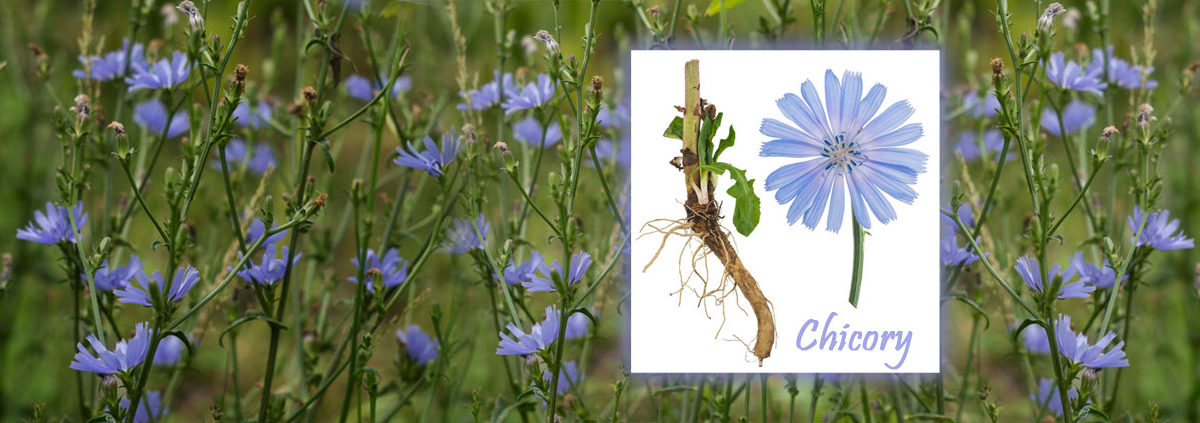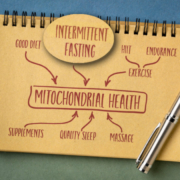The Magic of Chicory
Because this is my birthday week, I thought I would indulge myself and talk about some personal research I recently did. Today it’s all about chicory—it’s everywhere. The little purple flowers can be found alongside just about every road in Michigan. I’m pretty sure it’s probably that way across the U.S. where the climate is similar at this latitude. Those little lavender-purple flowers are chicory, officially known as Cichorium intybus, a member of the Aster family. This absolutely phenomenal lavender-flowered plant is one of those plants that are classified as weeds in some areas, but in others are cultivated for their nutritious parts.
Chicory as a Fiber Source
I first became aware of chicory when I found out the root is the source of one of my favorite types of fiber called inulin. The reason that I like that particular type of fiber so much is that it can act as a prebiotic and feed many of the bacteria of the microbiome. But first, it acts like any other type of soluble fiber: it absorbs fluid to help food move through the small intestine. Then when it gets to the large intestine, it can supply the thousands of microbes with food.
Chicory is not the only source of inulin, but it’s the greatest source. Here are some of the other major sources of inulin if you wanted to get it by eating plants; all of these amounts are per 100 grams of a serving; that works out to about 3.3 ounces:
- Chicory root contains about 40 grams
- Jerusalem artichoke has 16–20 grams
- Garlic has 9–16 grams
- Raw asparagus has 2–3 grams
It might be relatively easy to eat 3.3 ounces of artichokes or asparagus. But I’m not sure many people are going to want to be around you if you eat 3.3 ounces of raw garlic every day, although it could be a big assist in social distancing. Just a thought.
Chicory as Food
I was surprised to find out that almost the entire chicory plant can be eaten; it has been cultivated as food in Europe since the 1600s. Depending on the age of the plant, as well as the time within the growing season, the leaves of the plant can be considered a salad delicacy. I don’t usually stop and eat or even nibble when I’m out for a walk/run, but chicory is in the endive family and the flavor is supposed to be somewhat bitter and crunchy like endive. That’s if eaten raw. When cooked, the flavor mellows out quite a bit, as it does for dandelion greens, another relative. When used in foods, it appears that chicory is often eaten like celery. The leaves, the roots, and the leaf buds are boiled and added to foods. Chicory seems to get more intriguing as a potential food all the time.
Chicory has also been used as an additive to or a substitute for coffee. Evidently when dried and roasted it has a very distinctive flavor that enhances coffee. In fact, after World War II, England and Germany roasted chicory root as a substitute for coffee beans. While I’ve never tasted it, I know that there are several brands of American coffee that contain roasted chicory root. What I don’t know is how that might impact the ability to act as a fiber and prebiotic. Because you’re trying to extract flavor from the root plus roasting the root, there may not be any of the desired digestive qualities available.
Chicory as a Nutrient
Because it’s a plant, you know that it must have phytonutrients. I’ve talked about the benefits as it relates to the microbiome, but there may be other benefits from consuming the plant or extracts from the plant. For example, in some of my background research on this, it seems that some people apply a paste of chicory leaves on the skin for swelling and inflammation. In another trial on rodents, chicory was used in combination with a variety of other herbs to see if it would lower blood pressure. It did, but it’s still a long way from a very small study on rats to developing natural ways of dealing with blood pressure.
One thing is for sure: using the parts of the plant that we know are the most effective for the digestive system is probably a good idea. We know that adults should be getting 25 to 30 grams of fiber per day, but most people seem to be able to hit only between 12 and 13 grams. So if taking this type of fiber known as inulin sourced from chicory root or eating more artichokes and asparagus is possible, you’ll get a lot of benefit from this plant. Maybe this will inspire you to taste the leaves of the plant with the little purple flowers on the side of the road in your next salad.
That’s exactly what I did on a trip to the store before writing this Memo. I noticed some chicory growing on the side of the road in an area that had a little bit of parking. So I stopped my car, got out, picked several different sized leaves, and then ate them. The plant had blossoms so that may have made a difference in the flavor. It was extraordinarily bitter but left no aftertaste. It would be interesting to be able to get some chicory that was specifically designed to be used in salads to see if it would taste similar. I would say this: if you can drink an IPA, I think you could eat salad with chicory in it. That’s my experience with eating chicory leaves to date. I’ll stick with inulin from the root for now.
New Info and Some Time Off
There’s a new Basic Health Info posted on the Health Info page at drchet.com about the myths and facts of face masks as described in actual scientific research. If you’re tired of people throwing fantastic tales of masks’ effects at you, here’s where you can go to get the facts: Cloth Masks: What the Research Says
We’re taking next week off to catch up on some big chores around the house, maybe even relax an hour or two, so expect to hear from me again on August 4.
What are you prepared to do today?
Dr. Chet
Reference: BMC Complement Altern Med. 2017 (3) 7;17(1):142.









